Mapping Neuroscience in the Field of Education through a Bibliometric Analysis
Abstract
1. Introduction
2. Data and Methods
2.1. Data Collection
2.2. Data Processing
2.3. Strategic Diagram Construction
3. Results
3.1. Annual Publications Analysis
3.2. Performance Analysis
3.2.1. The Most Influential Countries
3.2.2. The Most Influential Institutions
3.2.3. The Most Influential Authors
3.2.4. The Most Influential Papers
3.2.5. The Most Influential Journals
3.3. Collaboration Network Analysis
3.3.1. Country Collaboration Network
3.3.2. Institutional Collaboration Network
3.3.3. Author Collaboration Network
3.4. Co-Citation Network Analysis
3.5. Research Themes Analysis
3.5.1. Core Research Themes for 1995–2013
3.5.2. Core Research Themes for 2014–2022
3.5.3. Evolution Analysis of Core Research Themes
3.6. Research Trend Analysis
4. Conclusions and Discussion
4.1. Research Conclusions
4.2. Implications for Academic Research
4.3. Research Limitations
Author Contributions
Funding
Conflicts of Interest
Abbreviations
References
- Eskine, K.E. Evaluating the three-network theory of creativity: Effects of music listening on resting state EEG. Psychol. Music 2022. [Google Scholar] [CrossRef]
- Mason, R.A.; Schumacher, R.A.; Just, M.A. The neuroscience of advanced scientific concepts. Npj Sci. Learn. 2021, 6, 1–12. [Google Scholar] [CrossRef]
- Lempp, R. School Performance of Epileptic Children and Their Physical and Sociological Status. Dtsch. Med. Wochenschr. 1970, 95, 629–633. [Google Scholar] [CrossRef] [PubMed]
- Xu, H.Q.; Chung, C.-C.; Yu, C. Visualizing Research Trends on Culture Neuroscience (2008–2021): A Bibliometric Analysis. Front. Psychol. 2022, 13, 2371. [Google Scholar] [CrossRef] [PubMed]
- Cozolino, L. The Social Neuroscience of Education: Optimizing Attachment and Learning in the Classroom (the Norton Series on the Social Neuroscience of Education); WW Norton & Company: New York, NY, USA, 2013. [Google Scholar]
- Sullivan, K.; Stone, W.L.; Dawson, G. Potential neural mechanisms underlying the effectiveness of early intervention for children with autism spectrum disorder. Res. Dev. Disabil. 2014, 35, 2921–2932. [Google Scholar] [CrossRef]
- Arantes, J.; Ferreira, M.A. Tools and resources for neuroanatomy education: A systematic review. BMC Med. Educ. 2018, 18, 1–15. [Google Scholar] [CrossRef] [PubMed]
- Wang, Y. Pulling at Your Heartstrings: Examining Four Leadership Approaches from the Neuroscience Perspective. Educ. Adm. Q. 2018, 55, 328–359. [Google Scholar] [CrossRef]
- Strohmaier, A.R.; MacKay, K.J.; Obersteiner, A.; Reiss, K.M. Eye-tracking methodology in mathematics education research: A systematic literature review. Educ. Stud. Math. 2020, 104, 147–200. [Google Scholar] [CrossRef]
- Ozel, P.; Mutlu-Bayraktar, D.; Altan, T.; Coskun, V.; Olamat, A. Neuroimaging tools in multimedia learning: A systematic review. Interact. Learn. Environ. 2021, 1–18. [Google Scholar] [CrossRef]
- Tenório, K.; Pereira, E.; Remigio, S.; Costa, D.; Oliveira, W.; Dermeval, D.; da Silva, A.P.; Bittencourt, I.I.; Marques, L.B. Brain-imaging techniques in educational technologies: A systematic literature review. Educ. Inf. Technol. 2021, 27, 1183–1212. [Google Scholar] [CrossRef]
- Arora, S.K.; Porter, A.; Youtie, J.; Shapira, P. Capturing new developments in an emerging technology: An updated search strategy for identifying nanotechnology research outputs. Scientometrics 2013, 95, 351–370. [Google Scholar] [CrossRef]
- Donthu, N.; Kumar, S.; Mukherjee, D.; Pandey, N.; Lim, W.M. How to conduct a bibliometric analysis: An overview and guidelines. J. Bus. Res. 2021, 133, 285–296. [Google Scholar] [CrossRef]
- Sakhnini, J.; Karimipour, H.; Dehghantanha, A.; Parizi, R.M.; Srivastava, G. Security aspects of Internet of Things aided smart grids: A bibliometric survey. Internet Things 2021, 14, 100111. [Google Scholar] [CrossRef]
- Kozlowski, D.; Larivière, V.; Sugimoto, C.R.; Monroe-White, T. Intersectional inequalities in science. Proc. Natl. Acad. Sci. USA 2022, 119, e2113067119. [Google Scholar] [CrossRef] [PubMed]
- Lin, C.-L.; Chen, Z.; Jiang, X.; Chen, G.L.; Jin, P. Roles and Research Trends of Neuroscience on Major Information Systems Journal: A Bibliometric and Content Analysis. Front. Neurosci. 2022, 16, 872532. [Google Scholar] [CrossRef] [PubMed]
- Paul, J.; Bhukya, R. Forty-five years of International Journal of Consumer Studies: A bibliometric review and directions for future research. Int. J. Consum. Stud. 2021, 45, 937–963. [Google Scholar] [CrossRef]
- Qiao, G.; Ding, L.; Zhang, L.; Yan, H. Accessible tourism: A bibliometric review (2008–2020). Tour. Rev. 2022, 77, 713–730. [Google Scholar] [CrossRef]
- Vogel, B.; Reichard, R.J.; Batistič, S.; Černe, M. A bibliometric review of the leadership development field: How we got here, where we are, and where we are headed. Leadersh. Q. 2021, 32, 101381. [Google Scholar] [CrossRef]
- Wang, B.; Tao, F.; Fang, X.; Liu, C.; Liu, Y.; Freiheit, T. Smart Manufacturing and Intelligent Manufacturing: A Comparative Review. Engineering 2021, 7, 738–757. [Google Scholar] [CrossRef]
- Van Eck, N.J.; Waltman, L. Software survey: VOSviewer, a computer program for bibliometric mapping. Scientometrics 2010, 84, 523–538. [Google Scholar] [CrossRef]
- Aria, M.; Cuccurullo, C. bibliometrix: An R-tool for comprehensive science mapping analysis. J. Informetr. 2017, 11, 959–975. [Google Scholar] [CrossRef]
- Donthu, N.; Kumar, S.; Pandey, N.; Gupta, P. Forty years of the International Journal of Information Management: A bibliometric analysis. Int. J. Inf. Manag. 2021, 57, 102307. [Google Scholar] [CrossRef]
- Martin-Martin, A.; Thelwall, M.; Orduna-Malea, E.; Lopez-Cozar, E.D. Google Scholar, Microsoft Academic, Scopus, Dimensions, Web of Science, and OpenCitations’ COCI: A multidisciplinary comparison of coverage via citations. Scientometrics 2021, 126, 907–908. [Google Scholar] [CrossRef]
- Zhang, J.; Yu, Q.; Zheng, F.; Long, C.; Lu, Z.; Duan, Z. Comparing keywords plus of WOS and author keywords: A case study of patient adherence research. J. Assoc. Inf. Sci. Technol. 2016, 67, 967–972. [Google Scholar] [CrossRef]
- Lozano, S.; Calzada-Infante, L.; Adenso-Díaz, B.; García, S. Complex network analysis of keywords co-occurrence in the recent efficiency analysis literature. Scientometrics 2019, 120, 609–629. [Google Scholar] [CrossRef]
- Yu, D.; Hong, X. A theme evolution and knowledge trajectory study in AHP using science mapping and main path analysis. Expert Syst. Appl. 2022, 205, 117675. [Google Scholar] [CrossRef]
- Zhu, X.; Zhang, Y. Co-word analysis method based on meta-path of subject knowledge network. Scientometrics 2020, 123, 753–766. [Google Scholar] [CrossRef]
- Blondel, V.D.; Guillaume, J.-L.; Lambiotte, R.; Lefebvre, E. Fast unfolding of communities in large networks. J. Stat. Mech. Theory Exp. 2008, 2008, P10008. [Google Scholar] [CrossRef]
- Smith, K.E.; Norman, G.J.; Decety, J. The complexity of empathy during medical school training: Evidence for positive changes. Med. Educ. 2017, 51, 1146–1159. [Google Scholar] [CrossRef] [PubMed]
- Kim, M.; Decety, J.; Wu, L.; Baek, S.; Sankey, D. Neural computations in children’s third-party interventions are modulated by their parents’ moral values. Npj Sci. Learn. 2021, 6, 1–13. [Google Scholar] [CrossRef] [PubMed]
- Li, T.; Decety, J.; Hu, X.; Li, J.; Lin, J.; Yi, L. Third-Party Sociomoral Evaluations in Children with Autism Spectrum Disorder. Child Dev. 2019, 90, e584–e597. [Google Scholar] [CrossRef]
- Meidenbauer, K.L.; Cowell, J.M.; Killen, M.; Decety, J. A Developmental Neuroscience Study of Moral Decision Making Regarding Resource Allocation. Child Dev. 2018, 89, 1177–1192. [Google Scholar] [CrossRef]
- Benjamin, S.; Travis, M.J.; Cooper, J.J.; Dickey, C.C.; Reardon, C.L. Neuropsychiatry and Neuroscience Education of Psychiatry Trainees: Attitudes and Barriers. Acad. Psychiatry 2014, 38, 135–140. [Google Scholar] [CrossRef] [PubMed]
- Lockhart, B.J.; Capurso, N.A.; Chase, I.; Arbuckle, M.R.; Travis, M.J.; Eisen, J.; Ross, D.A. The Use of a Small Private Online Course to Allow Educators to Share Teaching Resources across Diverse Sites: The Future of Psychiatric Case Conferences? Acad. Psychiatry 2017, 41, 81–85. [Google Scholar] [CrossRef] [PubMed]
- Arbuckle, M.R.; Travis, M.J.; Eisen, J.; Wang, A.; Walker, A.E.; Cooper, J.J.; Neeley, L.; Zisook, S.; Cowley, D.S.; Ross, D.A. Transforming Psychiatry from the Classroom to the Clinic: Lessons from the National Neuroscience Curriculum Initiative. Acad. Psychiatry 2020, 44, 29–36. [Google Scholar] [CrossRef]
- Gopalan, P.; Azzam, P.N.; Travis, M.J.; Schlesinger, A.; Lewis, D.A. Longitudinal Interdisciplinary Neuroscience Curriculum. Acad. Psychiatry 2014, 38, 163–167. [Google Scholar] [CrossRef]
- Drake, R.L.; McBride, J.M.; Lachman, N.; Pawlina, W. Medical education in the anatomical sciences: The winds of change continue to blow. Anat. Sci. Educ. 2009, 2, 253–259. [Google Scholar] [CrossRef]
- Drake, R.L.; McBride, J.M.; Pawlina, W. An update on the status of anatomical sciences education in United States medical schools. Anat. Sci. Educ. 2014, 7, 321–325. [Google Scholar] [CrossRef]
- McBride, J.M.; Drake, R.L. National survey on anatomical sciences in medical education. Anat. Sci. Educ. 2018, 11, 7–14. [Google Scholar] [CrossRef]
- Zinchuk, A.V.; Flanagan, E.P.; Tubridy, N.J.; Miller, W.A.; McCullough, L.D. Attitudes of US medical trainees towards neurology education: “Neurophobia”—A global issue. BMC Med. Educ. 2010, 10, 1–7. [Google Scholar] [CrossRef]
- Estevez, M.E.; Lindgren, K.A.; Bergethon, P. A novel three-dimensional tool for teaching human neuroanatomy. Anat. Sci. Educ. 2010, 3, 309–317. [Google Scholar] [CrossRef] [PubMed]
- Epstein, R.M.; Siegel, D.J.; Silberman, J. Self-monitoring in clinical practice: A challenge for medical educators. J. Contin. Educ. Health Prof. 2008, 28, 5–13. [Google Scholar] [CrossRef]
- Van Berkhout, E.T.; Malouff, J.M. The efficacy of empathy training: A meta-analysis of randomized controlled trials. J. Couns. Psychol. 2016, 63, 32–41. [Google Scholar] [CrossRef]
- Silvia, P.J. Intelligence and Creativity Are Pretty Similar after All. Educ. Psychol. Rev. 2015, 27, 599–606. [Google Scholar] [CrossRef]
- Abraham, W.C.; Jones, O.D.; Glanzman, D.L. Is plasticity of synapses the mechanism of long-term memory storage? Npj Sci. Learn. 2019, 4, 1–10. [Google Scholar] [CrossRef] [PubMed]
- de Freitas, S. Are Games Effective Learning Tools? A Review of Educational Games. Educ. Technol. Soc. 2018, 21, 74–84. [Google Scholar]
- Cohen, J. Statistical Power Analysis for the Behavioral Sciences; Routledge: New York, NY, USA, 2013. [Google Scholar]
- DSM-IV-TR. Diagnostic and Statistical Manual of Mental Disorders; American Psychiatric Association: Arlington, VA, USA, 2000. [Google Scholar]
- Hyönä, J.; Lorch, R.F., Jr.; Rinck, M. Eye movement measures to study global text processing. In The Mind’s Eye; Elsevier: North Holland, The Netherlands, 2003; pp. 313–334. [Google Scholar]
- Mayer, R.E. Multimedia learning. In Psychology of Learning and Motivation; Elsevier: New York, NY, USA, 2002; Volume 41, pp. 85–139. [Google Scholar]
- Paivio, A. Mental Representations: A Dual Coding Approach; Oxford University Press: New York, NY, USA, 1990. [Google Scholar]
- Holmqvist, K.; Nyström, M.; Andersson, R.; Dewhurst, R.; Jarodzka, H.; Van de Weijer, J. Eye Tracking: A Comprehensive Guide to Methods and Measures; OUP Oxford: London, UK, 2011. [Google Scholar]
- Goswami, U. Neuroscience and education: From research to practice? Nat. Rev. Neurosci. 2006, 7, 406–413. [Google Scholar] [CrossRef] [PubMed]
- Howard-Jones, P.A. Neuroscience and education: Myths and messages. Nat. Rev. Neurosci. 2014, 15, 817–824. [Google Scholar] [CrossRef]
- Just, M.A.; Carpenter, P.A. A theory of reading: From eye fixations to comprehension. Psychol. Rev. 1980, 87, 329. [Google Scholar] [CrossRef] [PubMed]
- Sweller, J.; Van Merrienboer, J.J.G.; Paas, F. Cognitive Architecture and Instructional Design. Educ. Psychol. Rev. 1998, 10, 251–296. [Google Scholar] [CrossRef]
- Rayner, K. Eye movements in reading and information processing: 20 years of research. Psychol. Bull. 1998, 124, 372–422. [Google Scholar] [CrossRef] [PubMed]
- Rayner, K.; Chace, K.H.; Slattery, T.; Ashby, J. Eye Movements as Reflections of Comprehension Processes in Reading. Sci. Stud. Read. 2006, 10, 241–255. [Google Scholar] [CrossRef]
- Lai, M.-L.; Tsai, M.-J.; Yang, F.-Y.; Hsu, C.-Y.; Liu, T.-C.; Lee, S.W.-Y.; Lee, M.-H.; Chiou, G.-L.; Liang, J.-C.; Tsai, C.-C. A review of using eye-tracking technology in exploring learning from 2000 to 2012. Educ. Res. Rev. 2013, 10, 90–115. [Google Scholar] [CrossRef]
- Hannus, M.; Hyönä, J. Utilization of Illustrations during Learning of Science Textbook Passages among Low- and High-Ability Children. Contemp. Educ. Psychol. 1999, 24, 95–123. [Google Scholar] [CrossRef]
- Mason, L.; Tornatora, M.C.; Pluchino, P. Do fourth graders integrate text and picture in processing and learning from an illustrated science text? Evidence from eye-movement patterns. Comput. Educ. 2013, 60, 95–109. [Google Scholar] [CrossRef]
- Mason, L.; Pluchino, P.; Tornatora, M.C.; Ariasi, N. An Eye-Tracking Study of Learning from Science Text with Concrete and Abstract Illustrations. J. Exp. Educ. 2013, 81, 356–384. [Google Scholar] [CrossRef]
- Brueckner, J.K.; Traurig, H. Students’ responses to the introduction of a digital laboratory guide in medical neuroscience. Med. Teach. 2003, 25, 643–648. [Google Scholar] [CrossRef]
- Goldberg, H.R.; McKhann, G.M. Student test scores are improved in a virtual learning environment. Adv. Physiol. Educ. 2000, 23, S59–S66. [Google Scholar] [CrossRef]
- Bacro, T.R.; Gebregziabher, M.; Fitzharris, T.P. Evaluation of a lecture recording system in a medical curriculum. Anat. Sci. Educ. 2010, 3, 300–308. [Google Scholar] [CrossRef]
- Walsh, J.P.; Sun, J.C.-Y.; Riconscente, M. Online Teaching Tool Simplifies Faculty Use of Multimedia and Improves Student Interest and Knowledge in Science. CBE—Life Sci. Educ. 2011, 10, 298–308. [Google Scholar] [CrossRef]
- Schneider, B.; Wallace, J.; Blikstein, P.; Pea, R. Preparing for Future Learning with a Tangible User Interface: The Case of Neuroscience. IEEE Trans. Learn. Technol. 2013, 6, 117–129. [Google Scholar] [CrossRef]
- Cheng, M.-T.; Annetta, L. Students’ learning outcomes and learning experiences through playing a Serious Educational Game. J. Biol. Educ. 2012, 46, 203–213. [Google Scholar] [CrossRef]
- Lopez-Rosenfeld, M.; Goldin, A.P.; Lipina, S.; Sigman, M.; Slezak, D.F. Mate Marote: A flexible automated framework for large-scale educational interventions. Comput. Educ. 2013, 68, 307–313. [Google Scholar] [CrossRef]
- Vicari, S.; Verucci, L.; Carlesimo, G.A. Implicit memory is independent from IQ and age but not from etiology: Evidence from down and Williams syndromes. J. Intellect. Disabil. Res. 2007, 51, 932–941. [Google Scholar] [CrossRef]
- Pulver, S.R.; Hornstein, N.J.; Land, B.L.; Johnson, B.R. Optogenetics in the teaching laboratory: Using channelrhodopsin-2 to study the neural basis of behavior and synaptic physiology in Drosophila. Adv. Physiol. Educ. 2011, 35, 82–91. [Google Scholar] [CrossRef][Green Version]
- Stewart, M. Helping students to understand that outward currents depolarize cells. Adv. Physiol. Educ. 1999, 276, S62. [Google Scholar] [CrossRef]
- Vargas, R.; Jóhannesdóttir, I.; Sigurgeirsson, B.; Þorsteinsson, H.; Karlsson, K. The zebrafish brain in research and teaching: A simple in vivo and in vitro model for the study of spontaneous neural activity. Adv. Physiol. Educ. 2011, 35, 188–196. [Google Scholar] [CrossRef]
- Sivam, S.P.; Iatridis, P.G.; Vaughn, S. Integration of pharmacology into a problem-based learning curriculum for medical students. Med. Educ. 1995, 29, 289–296. [Google Scholar] [CrossRef]
- Cunningham, J.T.; Freeman, R.H.; Hosokawa, M.C. Integration of neuroscience and endocrinology in hybrid pbl curriculum. Adv. Physiol. Educ. 2001, 25, 233–240. [Google Scholar] [CrossRef][Green Version]
- Cox, K. Perceiving clinical evidence. Med. Educ. 2002, 36, 1189–1195. [Google Scholar] [CrossRef][Green Version]
- Rubin, E.H.; Zorumski, C.F. Psychiatric Education in an Era of Rapidly Occurring Scientific Advances. Acad. Med. 2003, 78, 351–354. [Google Scholar] [CrossRef]
- Ruiter, D.J.; Van Kesteren, M.T.R.; Fernandez, G. How to achieve synergy between medical education and cognitive neuroscience? An exercise on prior knowledge in understanding. Adv. Health Sci. Educ. 2011, 17, 225–240. [Google Scholar] [CrossRef] [PubMed]
- Ghosh, S.; Pandya, H.V. Implementation of Integrated Learning Program in neurosciences during first year of traditional medical course: Perception of students and faculty. BMC Med. Educ. 2008, 8, 44. [Google Scholar] [CrossRef]
- Hodges, B.D.; Kuper, A. Theory and Practice in the Design and Conduct of Graduate Medical Education. Acad. Med. 2012, 87, 25–33. [Google Scholar] [CrossRef] [PubMed]
- Berninger, V.W.; Richards, T.L.; Abbott, R.D. Differential diagnosis of dysgraphia, dyslexia, and OWL LD: Behavioral and neuroimaging evidence. Read. Writ. 2015, 28, 1119–1153. [Google Scholar] [CrossRef] [PubMed]
- Dias, N.M.; Seabra, A.G. Intervention for executive functions development in early elementary school children: Effects on learning and behaviour, and follow-up maintenance. Educ. Psychol. 2016, 37, 468–486. [Google Scholar] [CrossRef]
- Zhang, W.; Zhang, L.; Liu, L.; Zhang, S. Improving Orthographic Awareness and Reading Fluency in Chinese Children with Dyslexia: A Case Study. Read. Writ. Q. 2020, 37, 1–16. [Google Scholar] [CrossRef]
- Howard, S.J.; Burianova, H.; Calleia, A.; Fynes-Clinton, S.; Kervin, L.; Bokosmaty, S. The method of educational assessment affects children’s neural processing and performance: Behavioural and fMRI Evidence. Npj Sci. Learn. 2017, 2, 10. [Google Scholar] [CrossRef] [PubMed]
- Pickering, J.D.; Panagiotis, A.; Ntakakis, G.; Athanassiou, A.; Babatsikos, E.; Bamidis, P.D. Assessing the difference in learning gain between a mixed reality application and drawing screencasts in neuroanatomy. Anat. Sci. Educ. 2021, 15, 628–635. [Google Scholar] [CrossRef] [PubMed]
- Svirko, E.; Mellanby, J. Teaching neuroanatomy using computer-aided learning: What makes for successful outcomes? Anat. Sci. Educ. 2017, 10, 560–569. [Google Scholar] [CrossRef]
- Hlavac, R.J.; Klaus, R.; Betts, K.; Smith, S.M.; Stabio, M.E. Novel dissection of the central nervous system to bridge gross anatomy and neuroscience for an integrated medical curriculum. Anat. Sci. Educ. 2018, 11, 185–195. [Google Scholar] [CrossRef] [PubMed]
- Rae, G.; Cork, R.J.; Karpinski, A.C.; Swartz, W.J. The integration of brain dissection within the medical neuroscience laboratory enhances learning. Anat. Sci. Educ. 2016, 9, 565–574. [Google Scholar] [CrossRef]
- Eriksson, K.; Englander, M. Empathy in Social Work. J. Soc. Work Educ. 2017, 53, 607–621. [Google Scholar] [CrossRef]
- Ekman, E.; Krasner, M. Empathy in medicine: Neuroscience, education and challenges. Med. Teach. 2017, 39, 164–173. [Google Scholar] [CrossRef] [PubMed]
- Riess, H.; Kraft-Todd, G. EMPATHY: A tool to enhance nonverbal communication between clinicians and their patients. Acad. Med. 2014, 89, 1108–1112. [Google Scholar] [CrossRef] [PubMed]
- Wellbery, C.; Saunders, P.A.; Kureshi, S.; Visconti, A. Medical Students’ Empathy for Vulnerable Groups: Results from a Survey and Reflective Writing Assignment. Acad. Med. 2017, 92, 1709–1714. [Google Scholar] [CrossRef] [PubMed]
- Gleichgerrcht, E.; Luttges, B.L.; Salvarezza, F.; Campos, A.L. Educational Neuromyths among Teachers in Latin America. Mind, Brain, Educ. 2015, 9, 170–178. [Google Scholar] [CrossRef]
- Dündar, S.; Gündüz, N. Misconceptions Regarding the Brain: The Neuromyths of Preservice Teachers. Mind Brain Educ. 2016, 10, 212–232. [Google Scholar] [CrossRef]
- Tovazzi, A.; Giovannini, S.; Basso, D. A New Method for Evaluating Knowledge, Beliefs, and Neuromyths about the Mind and Brain among Italian Teachers. Mind Brain Educ. 2020, 14, 187–198. [Google Scholar] [CrossRef]
- Wenger, E.; Lövdén, M. The Learning Hippocampus: Education and Experience-Dependent Plasticity. Mind Brain Educ. 2016, 10, 171–183. [Google Scholar] [CrossRef]
- Lee, H.S.; Fincham, J.M.; Anderson, J.R. Learning from Examples versus Verbal Directions in Mathematical Problem Solving. Mind Brain Educ. 2015, 9, 232–245. [Google Scholar] [CrossRef]
- Borst, G.; Cachia, A.; Tissier, C.; Ahr, E.; Simon, G.; Houdé, O. Early Cerebral Constraints on Reading Skills in School-Age Children: An MRI Study. Mind Brain Educ. 2016, 10, 47–54. [Google Scholar] [CrossRef]
- Luk, G.; Pliatsikas, C.; Rossi, E. Brain changes associated with language development and learning: A primer on methodology and applications. System 2020, 89, 102209. [Google Scholar] [CrossRef]
- Liu, C.-J.; Chiang, W.-W. Theory, method and practice of neuroscientific findings in science education. Int. J. Sci. Math. Educ. 2014, 12, 629–646. [Google Scholar] [CrossRef]
- Atteveldt, N.; Tijsma, G.; Janssen, T.; Kupper, F. Responsible Research and Innovation as a Novel Approach to Guide Educational Impact of Mind, Brain, and Education Research. Mind Brain Educ. 2019, 13, 279–287. [Google Scholar] [CrossRef] [PubMed]
- Dahlstrom-Hakki, I.; Asbell-Clarke, J.; Rowe, E. Showing is knowing: The potential and challenges of using neurocognitive measures of implicit learning in the classroom. Mind Brain Educ. 2019, 13, 30–40. [Google Scholar] [CrossRef]
- Campbell, K.; Chen, Y.-J.; Shenoy, S.; Cunningham, A.E. Preschool children’s early writing: Repeated measures reveal growing but variable trajectories. Read. Writ. 2019, 32, 939–961. [Google Scholar] [CrossRef]
- Hawes, Z.; Cain, M.; Jones, S.; Thomson, N.; Bailey, C.; Seo, J.; Caswell, B.; Moss, J. Effects of a Teacher-Designed and Teacher-Led Numerical Board Game Intervention: A Randomized Controlled Study with 4- to 6-Year-Olds. Mind Brain Educ. 2020, 14, 71–80. [Google Scholar] [CrossRef]
- Landi, N.; Kleinman, D.; Agrawal, V.; Ashton, G.; Coyne-Green, A.; Roberts, P.; Blair, N.; Russell, J.; Stutzman, A.; Scorrano, D.; et al. Researcher–practitioner partnerships and in-school laboratories facilitate translational research in reading. J. Res. Read. 2022, 45, 367–384. [Google Scholar] [CrossRef]
- Balta, J.Y.; Supple, B.; O’Keeffe, G.W. The Universal Design for Learning Framework in Anatomical Sciences Education. Anat. Sci. Educ. 2021, 14, 71–78. [Google Scholar] [CrossRef] [PubMed]
- Porter-Stransky, K.A.; Gallimore, R.M. Medical Student Attitudes and Perceptions on the Relevance of Neuroscience to Psychiatry: A Mixed Methods Study. Acad. Psychiatry 2022, 46, 128–132. [Google Scholar] [CrossRef] [PubMed]
- Nathaniel, T.I.; Goodwin, R.L.; Fowler, L.; McPhail, B.; Black, A.C. An Adaptive Blended Learning Model for the Implementation of an Integrated Medical Neuroscience Course during the COVID-19 Pandemic. Anat. Sci. Educ. 2021, 14, 699–710. [Google Scholar] [CrossRef] [PubMed]
- Rajan, K.K.; Pandit, A.S. Comparing computer-assisted learning activities for learning clinical neuroscience: A randomized control trial. BMC Med. Educ. 2022, 22, 1–12. [Google Scholar] [CrossRef] [PubMed]
- Rosati, A.; Lynch, J. Professional Learning on the Neuroscience of Challenging Behavior: Effects on Early Childhood Educators’ Beliefs and Practices. Day Care Early Educ. 2022, 1–11. [Google Scholar] [CrossRef]
- Solovieva, Y.; Baltazar-Ramos, A.-M.; Quintanar-Rojas, L.; Escotto-Córdova, E.-A.; Sidneva, A. Analysis of mathematics teaching programmes at preschool age based on activity theory (Análisis de programas de enseñanza de las matemáticas en la edad preescolar desde la teoría de la actividad). Cult. Educ. 2022, 34, 72–101. [Google Scholar] [CrossRef]
- Swan, P. The lived experience of empathic engagement in elementary classrooms: Implications for pedagogy. Teach. Teach. Educ. 2021, 102, 103324. [Google Scholar] [CrossRef]
- Yan, Z.; Pei, M.; Su, Y. Executive functions moderated the influence of physical cues on children’s empathy for pain: An eye tracking study. Early Child Dev. Care 2021, 191, 2204–2216. [Google Scholar] [CrossRef]
- Van Atteveldt, N.M.; van Kesteren, M.; Braams, B.; Krabbendam, L. Neuroimaging of learning and development: Improving ecological validity. Front. Learn. Res. 2018, 6, 186–203. [Google Scholar] [CrossRef]
- Van Noorden, R. Interdisciplinary research by the numbers. Nature 2015, 525, 306–307. [Google Scholar] [CrossRef]
- Parada, F.J.; Rossi, A. Commentary: Brain-to-Brain Synchrony Tracks Real-World Dynamic Group Interactions in the Classroom and Cognitive Neuroscience: Synchronizing Brains in the Classroom. Front. Hum. Neurosci. 2017, 11, 554. [Google Scholar] [CrossRef]
- Medina, M.; Lee, D.; Garza, D.M.; Goldwaser, E.L.; Truong, T.T.; Apraku, A.; Cosgrove, J.; Cooper, J.J. Neuroimaging Education in Psychiatry Residency Training: Needs Assessment. Acad. Psychiatry 2020, 44, 311–315. [Google Scholar] [CrossRef] [PubMed]
- Johnson, D.W.; Johnson, R.T.; Smith, K. The State of Cooperative Learning in Postsecondary and Professional Settings. Educ. Psychol. Rev. 2007, 19, 15–29. [Google Scholar] [CrossRef]
- Farkish, A.; Bosaghzadeh, A.; Amiri, S.H.; Ebrahimpour, R. Evaluating the Effects of Educational Multimedia Design Principles on Cognitive Load Using EEG Signal Analysis. Educ. Inf. Technol. 2022, 1–17. [Google Scholar] [CrossRef]
- Hidi, S. Revisiting the Role of Rewards in Motivation and Learning: Implications of Neuroscientific Research. Educ. Psychol. Rev. 2016, 28, 61–93. [Google Scholar] [CrossRef]
- Davidesco, I.; Matuk, C.; Bevilacqua, D.; Poeppel, D.; Dikker, S. Neuroscience Research in the Classroom: Portable Brain Technologies in Education Research. Educ. Res. 2021, 50, 649–656. [Google Scholar] [CrossRef]
- Roberts, M.E.; Stewart, B.M.; Tingley, D. stm: An R Package for Structural Topic Models. J. Stat. Softw. 2019, 91, 1–40. [Google Scholar] [CrossRef]
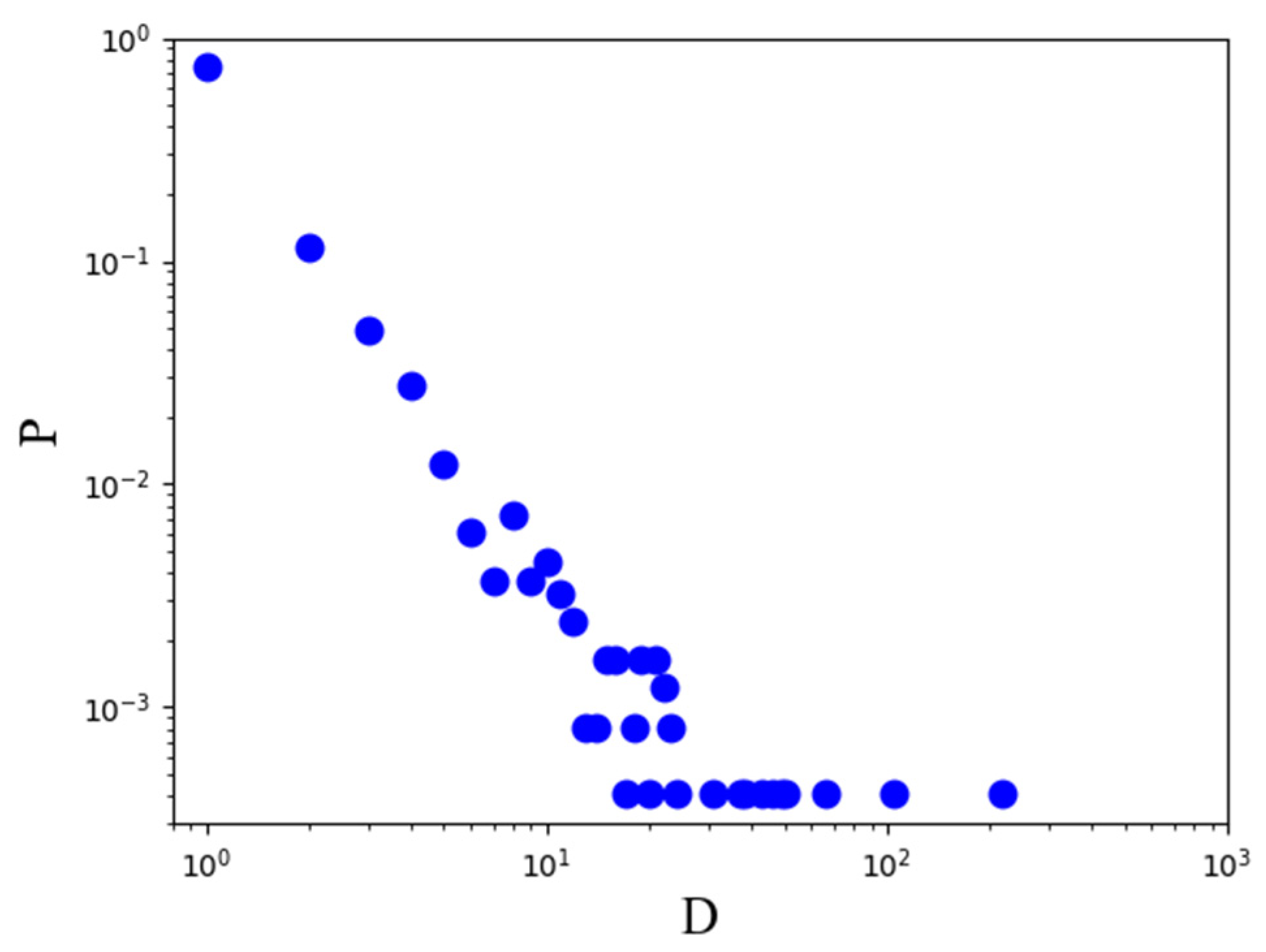


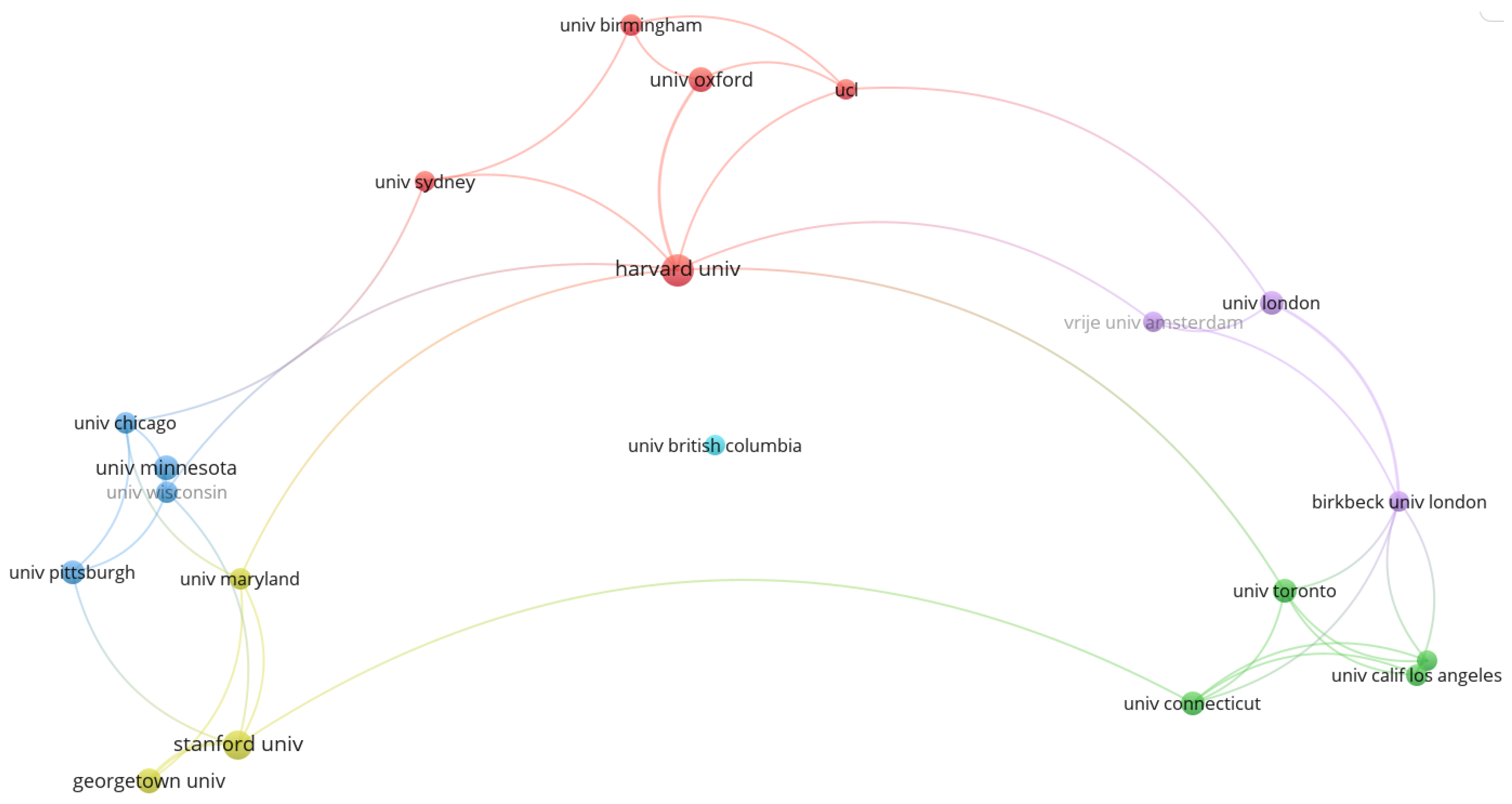

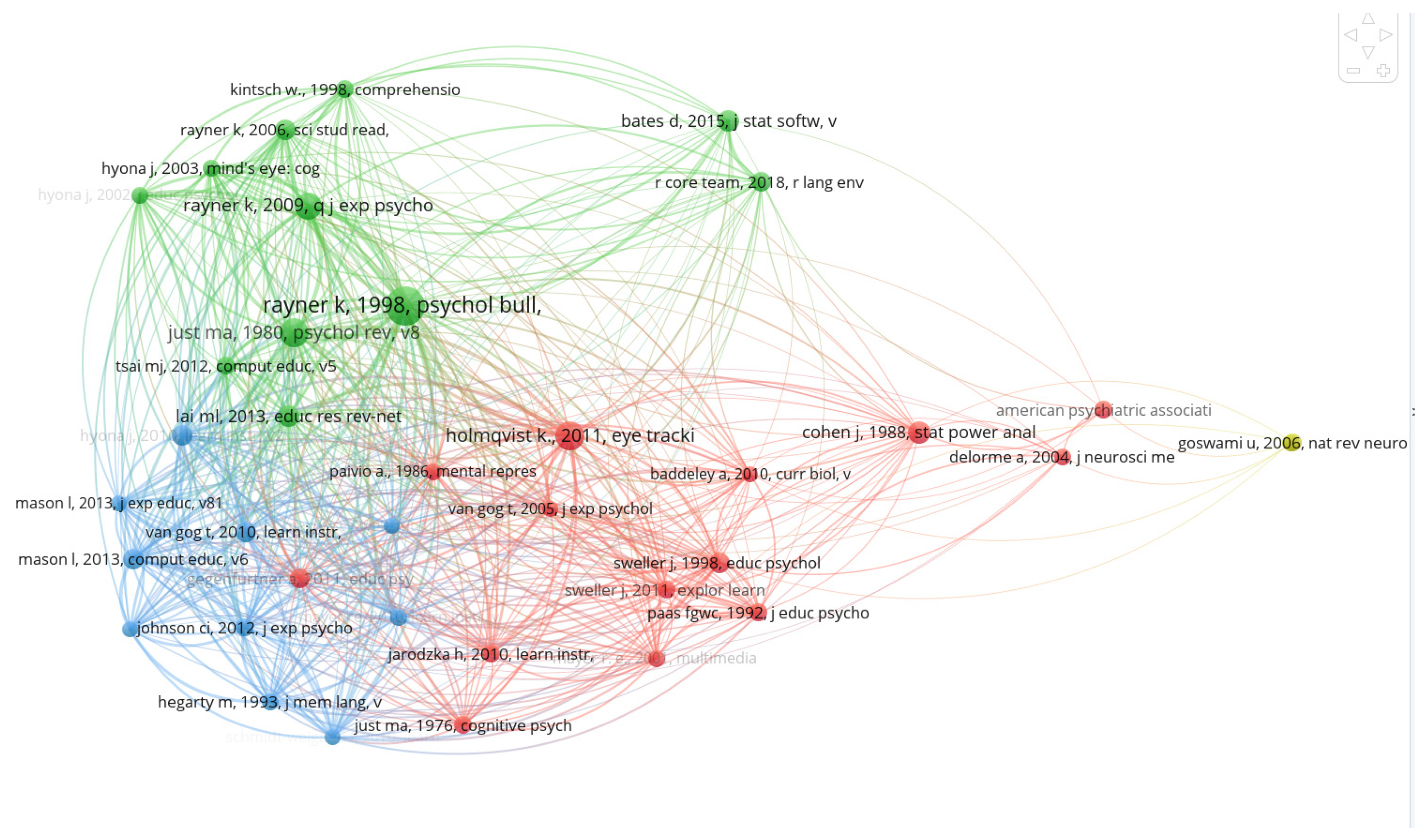
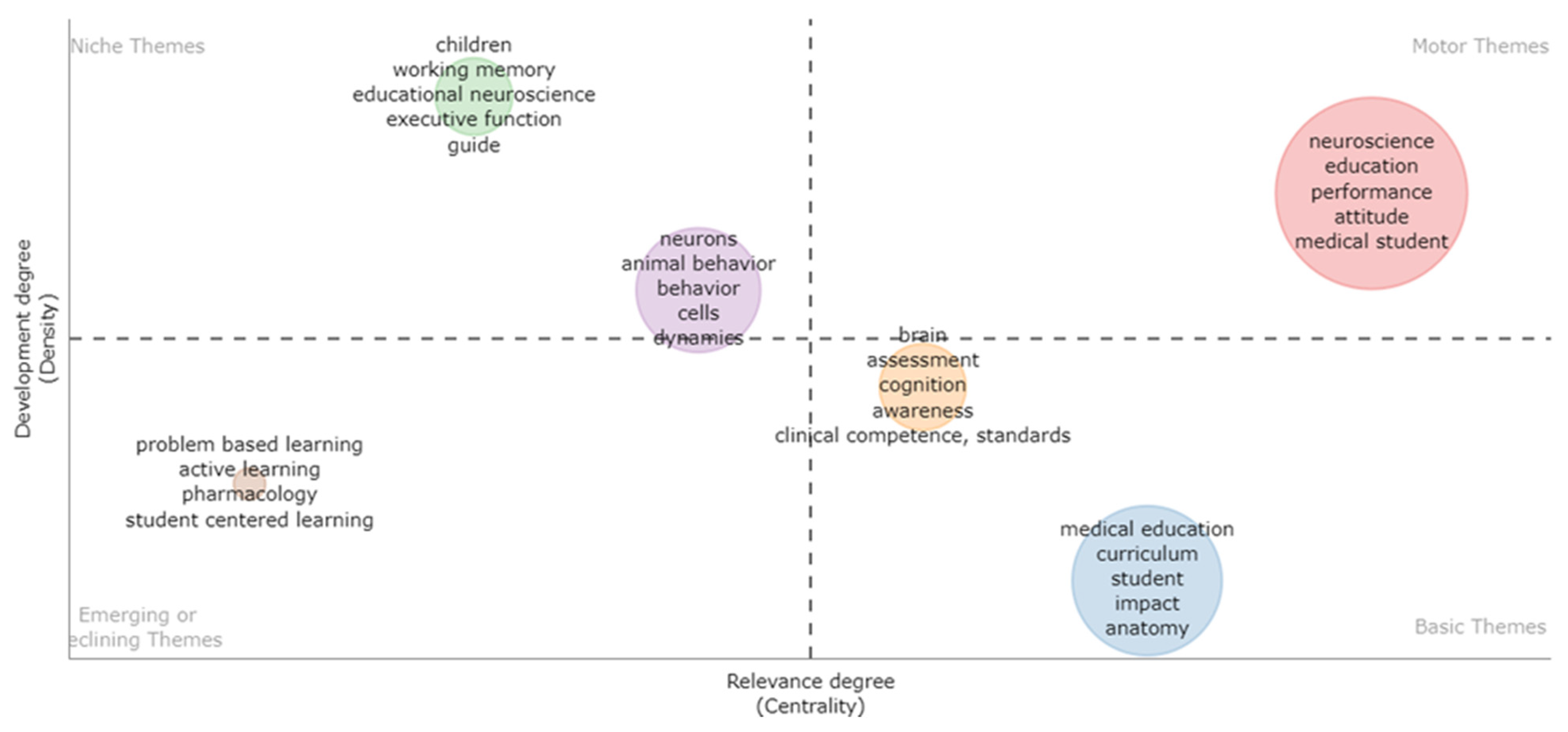
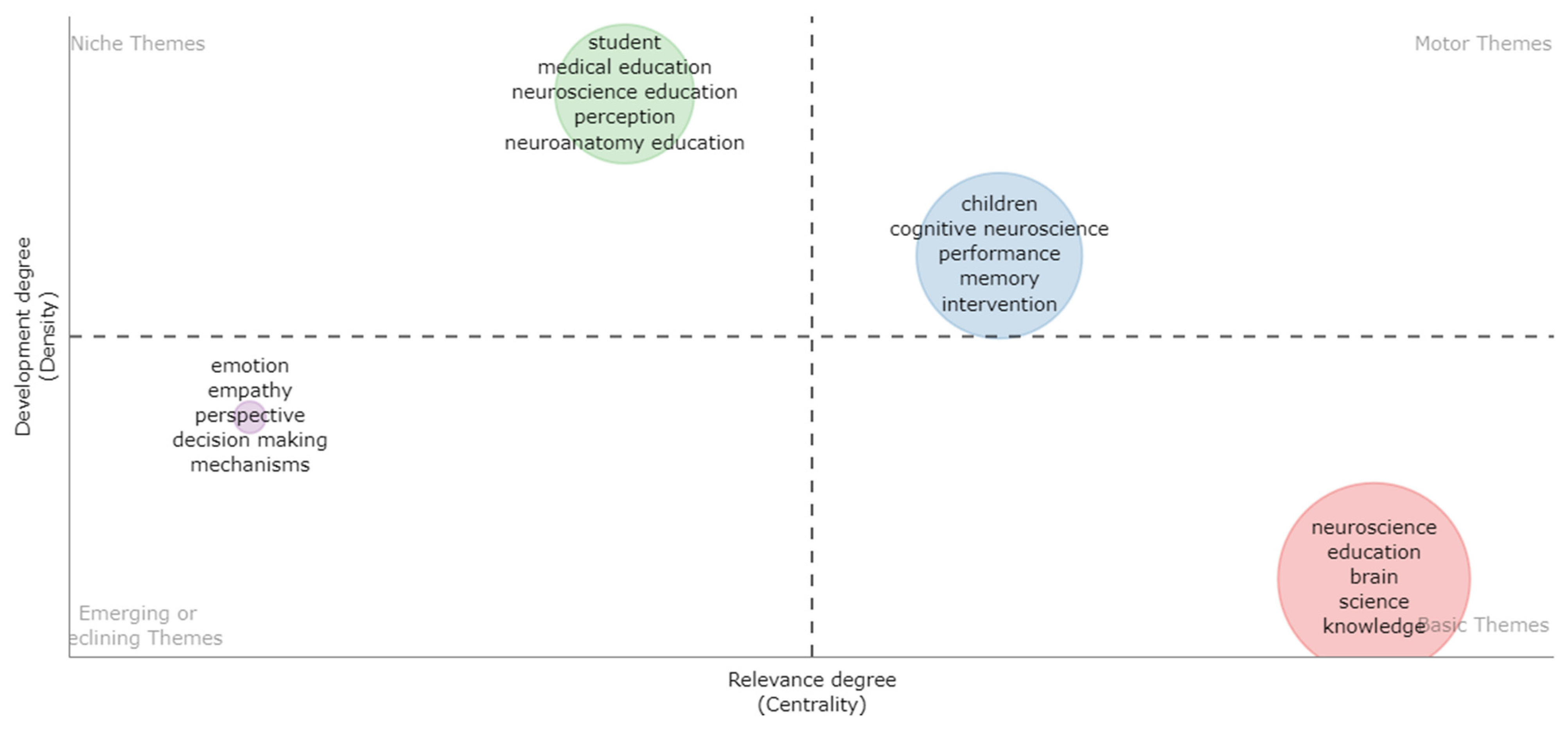
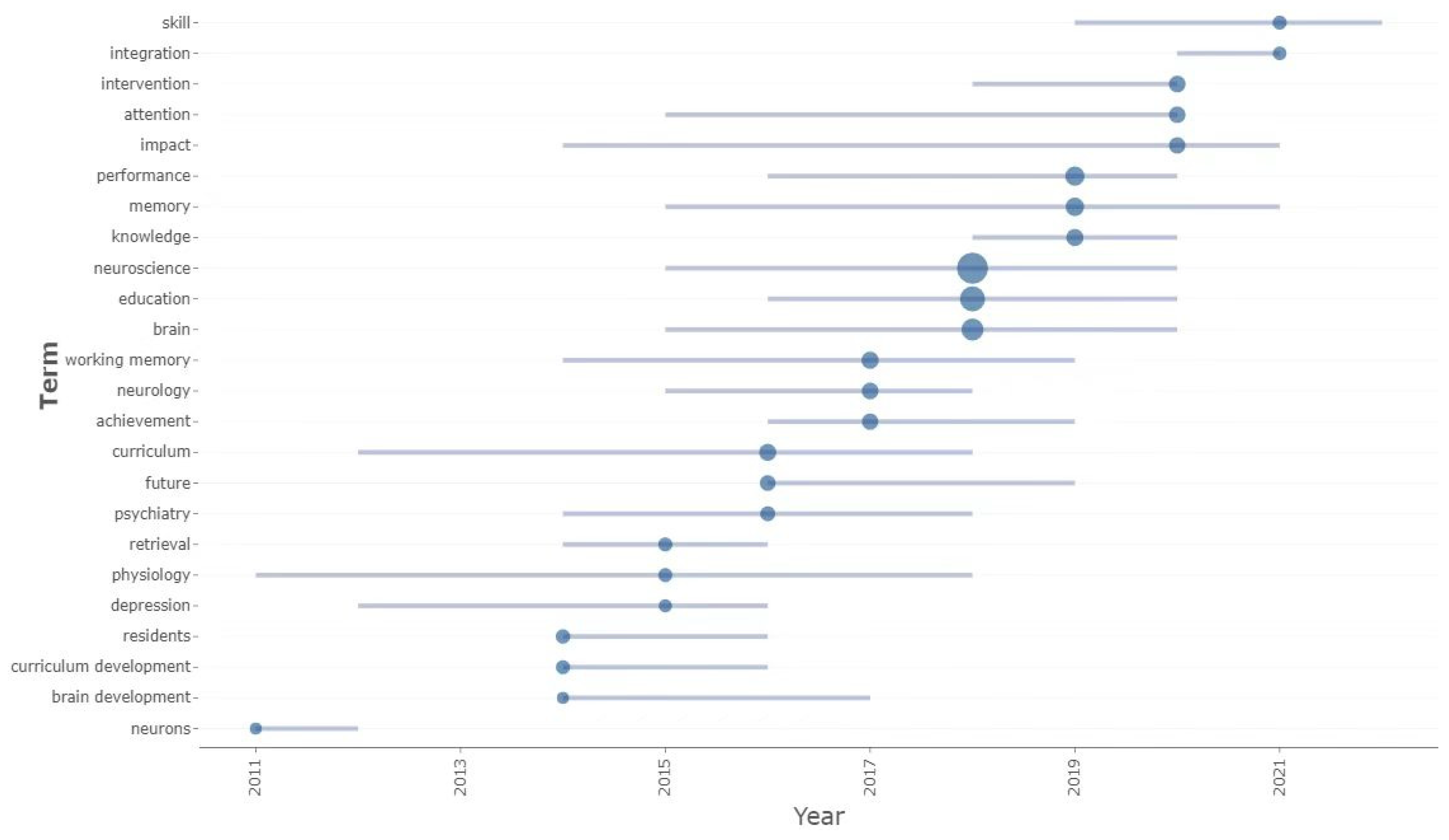
| Author | Research Topic | Number of Reviewed Articles |
|---|---|---|
| [7] | Tools and resources for neuroanatomy education | 214 |
| [8] | Neuroscience and educational leadership | 73 |
| [9] | Eye-tracking methodology in mathematics education | 161 |
| [10] | Neuroimaging tools in multimedia learning | 40 |
| [11] | Brain-imaging techniques in educational technologies | 37 |
| Description | Results |
|---|---|
| Timespan | 1995:2022 |
| Journals | 171 |
| Documents | 549 |
| Annual growth rate (%) | 9.81 |
| Average citations per document | 11.38 |
| References | 25,681 |
| Keywords | 2451 |
| Authors | 1584 |
| Authors of single-authored documents | 132 |
| Co-authors per document | 3.14 |
| International co-authorships (%) | 16.76 |
| Rank | Country | Papers | Citations |
|---|---|---|---|
| 1 | USA | 248 | 3743 |
| 2 | England | 83 | 829 |
| 3 | Australia | 39 | 335 |
| 4 | Canada | 37 | 325 |
| 5 | People’s Republic of China | 22 | 121 |
| 6 | Netherlands | 19 | 215 |
| 7 | Spain | 18 | 90 |
| 8 | Italy | 17 | 169 |
| 9 | Germany | 16 | 95 |
| 10 | Sweden | 12 | 102 |
| Rank | Institution | Papers | Citations |
|---|---|---|---|
| 1 | Harvard University | 15 | 227 |
| 2 | Stanford University | 12 | 190 |
| 3 | Georgetown University | 9 | 70 |
| 4 | University of Oxford | 9 | 94 |
| 5 | University of Pittsburgh | 8 | 113 |
| 6 | University of Connecticut | 8 | 120 |
| 7 | University of Toronto | 8 | 158 |
| 8 | University of London | 8 | 127 |
| 9 | University of Minnesota | 8 | 54 |
| 10 | University of California, Los Angeles | 7 | 346 |
| Rank | Author | h_index | g_index | TC | NP | PY_start |
|---|---|---|---|---|---|---|
| 1 | Decety J | 4 | 4 | 119 | 5 | 2014 |
| 2 | Travis MJ | 4 | 4 | 46 | 5 | 2014 |
| 3 | Akil M | 3 | 3 | 30 | 3 | 2014 |
| 4 | Benjamin S | 3 | 3 | 45 | 3 | 2014 |
| 5 | Cooper JJ | 3 | 3 | 33 | 3 | 2014 |
| 6 | Drake RL | 3 | 3 | 755 | 3 | 2009 |
| 7 | Etkin A | 3 | 4 | 68 | 4 | 2014 |
| 8 | Lee CD | 3 | 3 | 31 | 3 | 2016 |
| 9 | Mcbride JM | 3 | 3 | 755 | 3 | 2009 |
| 10 | Ross DA | 3 | 3 | 34 | 3 | 2014 |
| Author | Title | Journal | Citation |
|---|---|---|---|
| Drake (2009) [38] | Medical education in the anatomical sciences: the winds of change continue to blow | Anatomical Sciences Education | 519 |
| Epstein (2008) [43] | Self-monitoring in clinical practice: a challenge for medical educators | Journal of Continuing Education in the Health Professions | 185 |
| Drake (2014) [39] | An update on the status of anatomical sciences Education in United States medical schools | Anatomical Sciences Education | 161 |
| Van Berkhout and Malouff (2016) [44] | The efficacy of empathy training: a meta-analysis of randomized controlled trials | Journal of Counseling Psychology | 138 |
| Estevez (2010) [42] | A novel three-dimensional tool for teaching human neuroanatomy | BMC Medical Education | 114 |
| Zinchuk (2010) [41] | Attitudes of us medical trainees toward neurology education: “neurophobia”, a global issue | Anatomical Sciences Education | 113 |
| Mcbride (2018) [40] | National survey on anatomical sciences in medical education | Anatomical Sciences Education | 112 |
| Silvia (2015) [45] | Intelligence and creativity are pretty similar after all | Educational Psychology Review | 99 |
| Abraham (2019) [46] | Is plasticity of synapses the mechanism of long-term memory storage? | NPJ Science of Learning | 92 |
| De freitas (2018) [47] | Are games effective learning tools? A review of educational games | Educational Technology & Society | 77 |
| Rank | Sources | Articles | Citations |
|---|---|---|---|
| 1 | Mind Brain and Education | 52 | 374 |
| 2 | Academic Psychiatry | 32 | 241 |
| 3 | Anatomical Sciences Education | 31 | 1174 |
| 4 | Advances in Physiology Education | 29 | 237 |
| 5 | BMC Medical Education | 14 | 272 |
| 6 | Academic Medicine | 13 | 363 |
| 7 | Educational Philosophy and Theory | 13 | 37 |
| 8 | NPJ Science of Learning | 12 | 162 |
| 9 | CBE-Life Sciences Education | 10 | 116 |
| 10 | Early Child Development and Care | 10 | 25 |
| ID | Q | Most Frequently Used Keywords | Size | Total Frequency |
|---|---|---|---|---|
| C01 | QI: motor themes | Neuroscience (20); education (13); performance (7); attitude (5); medical student (4) | 19 | 84 |
| C02 | QII: niche themes | Children (5); working memory (3); educational neuroscience (2); executive function (2); guide (2) | 6 | 16 |
| C03 | QII: niche themes | Neurons (5); animal behavior (3); behavior (3); cells (2); dynamics (2) | 12 | 29 |
| C04 | QIII: emerging or declining themes | Problem-based learning (3); active learning (2); pharmacology (2); student-centered learning (2) | 4 | 9 |
| C05 | QVI: basic themes | Brain (7); assessment (4); cognition (3); awareness (3); clinical competence standards (2) | 7 | 22 |
| C06 | QVI: basic themes | Medical education (11); curriculum (11); student (9); impact (6); anatomy (5) | 10 | 40 |
| ID | Q | Most Frequently Used Keywords | Size | Total Frequency |
|---|---|---|---|---|
| C07 | QI: motor themes | Children (50); cognitive neuroscience (40); performance (35); memory (30); intervention (23) | 36 | 511 |
| C08 | QII: niche themes | Student (39); medical education (35); neuroscience education (24); perception (21); neuroanatomy education (20) | 28 | 400 |
| C09 | QIII: emerging or declining themes | Emotion (20); empathy (17); perspective (11); decision making (10); mechanisms (8) | 11 | 102 |
| C10 | QIV: basic themes | Neuroscience (201); education (96); brain (62); science (46); knowledge (24) | 37 | 739 |
Publisher’s Note: MDPI stays neutral with regard to jurisdictional claims in published maps and institutional affiliations. |
© 2022 by the authors. Licensee MDPI, Basel, Switzerland. This article is an open access article distributed under the terms and conditions of the Creative Commons Attribution (CC BY) license (https://creativecommons.org/licenses/by/4.0/).
Share and Cite
Xu, H.; Cheng, X.; Wang, T.; Wu, S.; Xiong, Y. Mapping Neuroscience in the Field of Education through a Bibliometric Analysis. Brain Sci. 2022, 12, 1454. https://doi.org/10.3390/brainsci12111454
Xu H, Cheng X, Wang T, Wu S, Xiong Y. Mapping Neuroscience in the Field of Education through a Bibliometric Analysis. Brain Sciences. 2022; 12(11):1454. https://doi.org/10.3390/brainsci12111454
Chicago/Turabian StyleXu, Hanqing, Xinyan Cheng, Ting Wang, Shufen Wu, and Yongqi Xiong. 2022. "Mapping Neuroscience in the Field of Education through a Bibliometric Analysis" Brain Sciences 12, no. 11: 1454. https://doi.org/10.3390/brainsci12111454
APA StyleXu, H., Cheng, X., Wang, T., Wu, S., & Xiong, Y. (2022). Mapping Neuroscience in the Field of Education through a Bibliometric Analysis. Brain Sciences, 12(11), 1454. https://doi.org/10.3390/brainsci12111454





